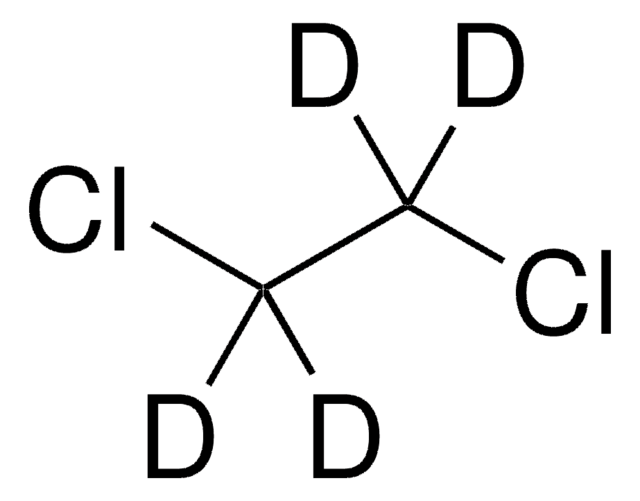319929
1,2-Dichloroéthane
ACS reagent, ≥99.0%
Synonyme(s) :
Chlorure d’éthylène, Dichlorure d’éthylène
About This Item
Produits recommandés
Qualité
ACS reagent
Niveau de qualité
Densité de vapeur
3.4 (20 °C, vs air)
Pression de vapeur
87 mmHg ( 25 °C)
Essai
≥99.0%
Forme
liquid
Température d'inflammation spontanée
775 °F
Limite d'explosivité
15.6 %
dilution
(for analytical testing)
Impuretés
≤0.0003 meq/g Titr. acid
≤0.03% water
Résidus d'évap.
≤0.002%
Couleur
APHA: ≤10
clear
Indice de réfraction
n20/D 1.444 (lit.)
pb
83 °C (lit.)
Pf
−35 °C (lit.)
Densité
1.256 g/mL at 25 °C (lit.)
Chaîne SMILES
ClCCCl
InChI
1S/C2H4Cl2/c3-1-2-4/h1-2H2
Clé InChI
WSLDOOZREJYCGB-UHFFFAOYSA-N
Vous recherchez des produits similaires ? Visite Guide de comparaison des produits
Description générale
Application
- As electron acceptor in the culture medium of Dehalococcoides ethenogenes 195.
- As model compound for chlorinated organics in various studies.
- Chemical doping during the fabrication of Cl-doped few-layer WS2 or MoS2 back gate field-effect transistors (FETs).
Mention d'avertissement
Danger
Mentions de danger
Classification des risques
Acute Tox. 3 Inhalation - Acute Tox. 4 Oral - Asp. Tox. 1 - Carc. 1B - Eye Irrit. 2 - Flam. Liq. 2 - Skin Irrit. 2 - STOT SE 3
Organes cibles
Respiratory system
Code de la classe de stockage
3 - Flammable liquids
Classe de danger pour l'eau (WGK)
WGK 3
Point d'éclair (°F)
55.4 °F - closed cup
Point d'éclair (°C)
13 °C - closed cup
Listes réglementaires
Les listes réglementaires sont principalement fournies pour les produits chimiques. Seules des informations limitées peuvent être fournies ici pour les produits non chimiques. L'absence d'indication signifie qu'aucun des composants n'est répertorié. Il incombe à l'utilisateur de s'assurer de l'utilisation sûre et légale du produit.
EU REACH SVHC Candidate List
EU REACH Annex XVII (Restriction List)
EU REACH Annex XIV (Authorisation List)
Faites votre choix parmi les versions les plus récentes :
Déjà en possession de ce produit ?
Retrouvez la documentation relative aux produits que vous avez récemment achetés dans la Bibliothèque de documents.
Notre équipe de scientifiques dispose d'une expérience dans tous les secteurs de la recherche, notamment en sciences de la vie, science des matériaux, synthèse chimique, chromatographie, analyse et dans de nombreux autres domaines..
Contacter notre Service technique









